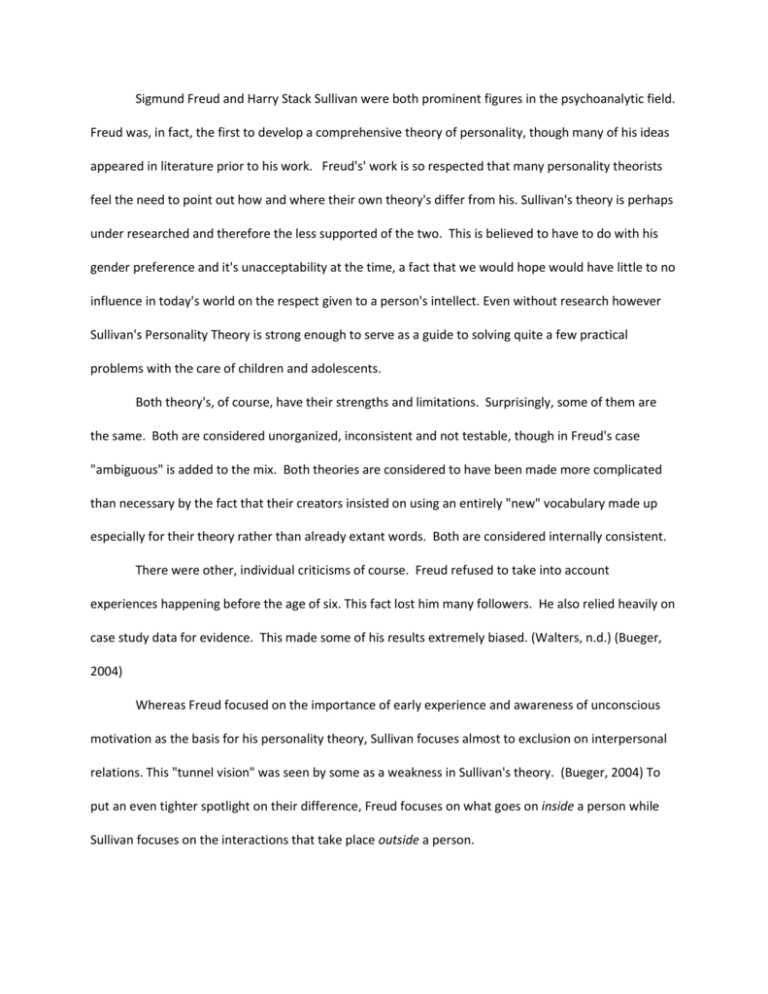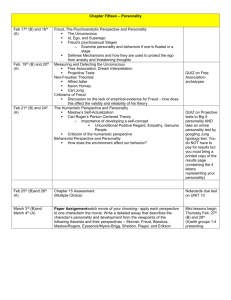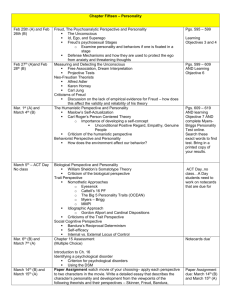References - JustAnswer
advertisement

Sigmund Freud and Harry Stack Sullivan were both prominent figures in the psychoanalytic field. Freud was, in fact, the first to develop a comprehensive theory of personality, though many of his ideas appeared in literature prior to his work. Freud's' work is so respected that many personality theorists feel the need to point out how and where their own theory's differ from his. Sullivan's theory is perhaps under researched and therefore the less supported of the two. This is believed to have to do with his gender preference and it's unacceptability at the time, a fact that we would hope would have little to no influence in today's world on the respect given to a person's intellect. Even without research however Sullivan's Personality Theory is strong enough to serve as a guide to solving quite a few practical problems with the care of children and adolescents. Both theory's, of course, have their strengths and limitations. Surprisingly, some of them are the same. Both are considered unorganized, inconsistent and not testable, though in Freud's case "ambiguous" is added to the mix. Both theories are considered to have been made more complicated than necessary by the fact that their creators insisted on using an entirely "new" vocabulary made up especially for their theory rather than already extant words. Both are considered internally consistent. There were other, individual criticisms of course. Freud refused to take into account experiences happening before the age of six. This fact lost him many followers. He also relied heavily on case study data for evidence. This made some of his results extremely biased. (Walters, n.d.) (Bueger, 2004) Whereas Freud focused on the importance of early experience and awareness of unconscious motivation as the basis for his personality theory, Sullivan focuses almost to exclusion on interpersonal relations. This "tunnel vision" was seen by some as a weakness in Sullivan's theory. (Bueger, 2004) To put an even tighter spotlight on their difference, Freud focuses on what goes on inside a person while Sullivan focuses on the interactions that take place outside a person. Freud believed that every person had within them a limited quantity of "psychic energy" which was needed in order for anything to happen within the body; this includes feeling, thinking, planning, remembering, everything. This energy was obtained from two sources: Eros (the libido, life and sexual instincts) and Thanatos (Death Instinct). The theory went that if this energy was tied up dealing with tension, anxiety or other negative life events then the psychic energy was not being used effectively. If these neuroses can be solved, then the energy can then be used in a more effective manner. Though Sullivan's theory does deal somewhat with energy, it is the energy of transformations and it is ever-present. There is no thought to having to "recharge" this energy; it is something we as humans always have to use in satisfying needs and reducing anxiety. Sullivan saw energy as existing in two forms, either as tension (potentiality for action) or as the actions themselves (energy transformations). To Sullivan, needs and anxiety were two of the driving forces behind our actions. Needs are type of tension which is an episodic, originally biological imbalance between the person and their physiochemical environment, the most basic of which is tenderness. Anxiety is more vague. It is inconsistent in what it needs for relief and is "the chief disruptive force blocking the development of healthy interpersonal relations." (Major Themes & Assumptions, 2003) There are both similarities and differences in how Freud dealt with anxiety and needs. Like Sullivan, he saw needs and anxieties as "conflicts" that had to be effectively resolved in order for the person to function at their best. But whereas Sullivan connected these needs and anxieties with interpersonal interactions, Freud connected them with psychic inner conflicts interfering with the urge for psychosexual pleasures relating to the stage that person was in. This related to his stages, the Id (the irrational, emotional part of the mind), the Ego (rational part), and the Superego (the moral part) and how well anxiety and needs were handled within each stage could affect a child's or adult's personality for the rest of their life. It could even result in them being "stuck" in a stage. Both Freud and Sullivan's theories are highly deterministic in that they treat difficulties encountered as behaviors with actual causes rather than amorphous mysteries of undetermined origin. Freud felt that everything had a cause, down to the slightest slip of the tongue. He felt that dreams and obsessive behavior had root causes in the person's mind that could be revealed through psychoanalysis. He used the analogy of an iceberg, most of it lying underneath the ice, to identify the conscious and unconscious mind and that which can act upon it. In this way Freud also expressed his awareness of self in his theory. (Topography of Mind:Freud's Iceberg Model for Unconscious, Pre-conscious, & Conscious , 2003) Freud stated that there were three levels of consciousness (or awareness): the conscious (littlest) - holds that of which you are aware. You can talk about conscious experiences and think about them logically preconscious (medium) - typical memories - Things here are not stored in conscious memory but are easily reachable when needed. unconscious (huge) - not directly accessible to awareness. According to Freud these thoughts and feelings do not just disappear. They remain and continue to exert influence on our actions and conscious awareness. It is here that most of the work of the Id, Ego, and Superego happens. (Major Themes & Assumptions, 2003) Determinism and self awareness in Sullivan's personality theory are expressed through processes known as "Dynamisms" and "Self-Systems". Dynamisms are behavior patterns that come to characterize a person throughout their lifetime. They are of two major classes; those related to specific zones of the body and those related to tensions. The second class is further separated in to three categories; disjunctive, isolating and conjunctive. Malevolence (the feeling of living among enemies) would be an example of a disjunctive dynamism. An example of an isolating dynamism would be lust or any behavior pattern relating to interpersonal relations. Conjunctive dynamisms would include beneficial patterns such as the self-system and intimacy. All are thought to be caused by met or unmet needs, behaviors, incidents, or feelings during various stages of life. Sullivan's "self- system" refers to a pattern of behaviors which begins to build at a very young age, 12 to 18 months, in which we begin to detect which behaviors relate to increasing or decreasing anxiety. This ability to detect increases or decreases in anxiety provides us with a kind of "early warning system." Unfortunately, at the same time it is insulating us from anxiety it has at the same time become our "foremost stumbling block to favorable changes in personality" by the very act of insulating us. Sullivan however believed that this was offset by the resilience and openness to change of the personality especially at the beginning of each stage of development. (Major Themes & Assumptions, 2003) Both Freud and Sullivan were controversial, revolutionary, and influential in the field of psychology as well as particularly in the field of personality theory. While their focuses were different, one inward and the other outward, they both transformed personality theory in their own way by providing explanations about the nature of human behavior. Freud and Sullivan each provided explanations of personality and human behavior from a unique perspective. References 1.Bueger, J. (2004). Personality: Sixth edition. Thomson & Wadsworth. 2. InternetEncyclopedia of Philosophy: A Peer Reviewed Academic Resource. (2005, July 15). Retrieved June 15, 2010, from Sigmund Freud (1856—1939): http://www.iep.utm.edu/freud/ 3. Major Themes & Assumptions. (2003, September 21). Retrieved June 15, 2010, from http://wilderdom.com/personality/L8-1MajorThemesAssumptionsPsychoanalytic.html 4. Mitchell, S. B. (1995). Freud and beyond: a history of modern psychoanalytic thought. Basic Books. 5. Personality Synopsis. (2004, March 23). Retrieved June 17, 2010, from AllPsych Online: http://allpsych.com/personalitysynopsis/stack_sullivan.html 6. Regan, T. (n.d.). The Matrix of Personality: A Whiteheadian Corroboration of Harry Stack Sullivan’s Interpersonal Theo. Retrieved June 17, 2010, from http://www.religiononline.org/showarticle.asp?title=2799 7. Topography of Mind:Freud's Iceberg Model for Unconscious, Pre-conscious, & Conscious . (2003, September 22). Retrieved June 15, 2010, from http://wilderdom.com/personality/L83TopographyMindIceberg.html 8. Walters, H. (n.d.). Chapter 2: Theories of Human Development. Retrieved June 17, 2010, from Lewis Clark State College: http://www.lcsc.edu/hbwalters/Human%20Development%20PDF/Chapter%202.%20Theories%20of%20 Human%20Development.pdf







